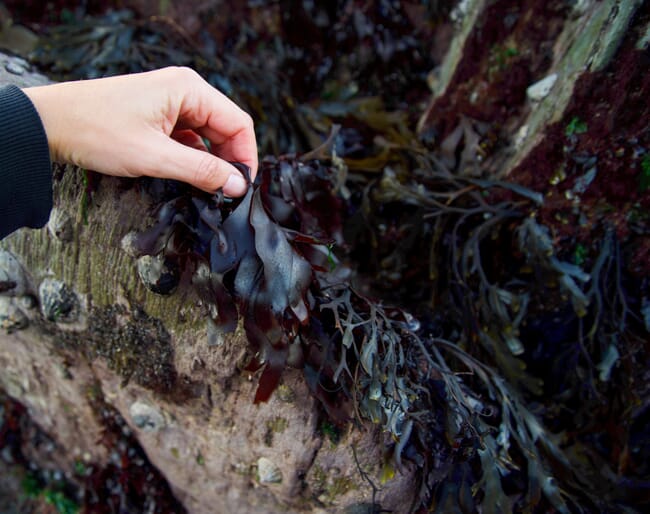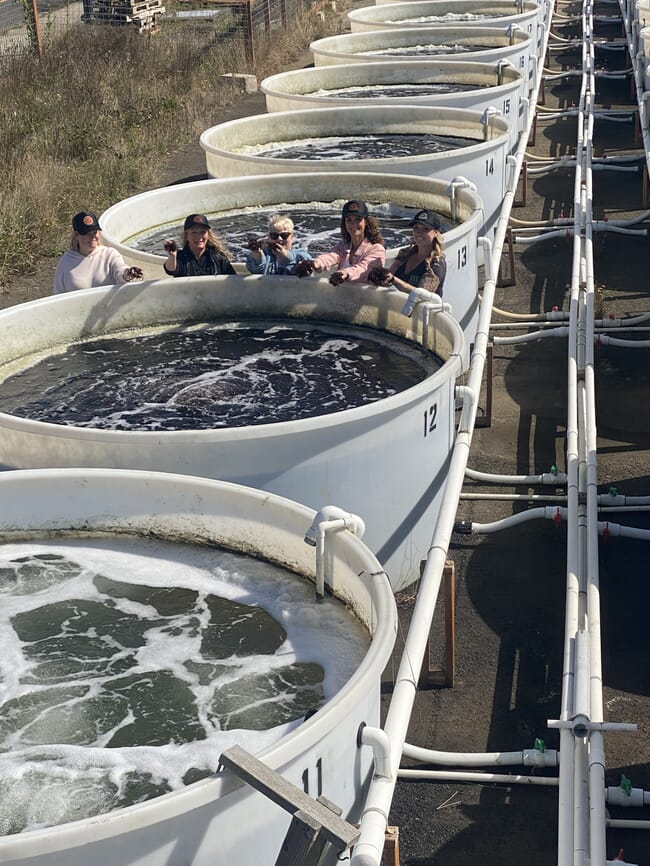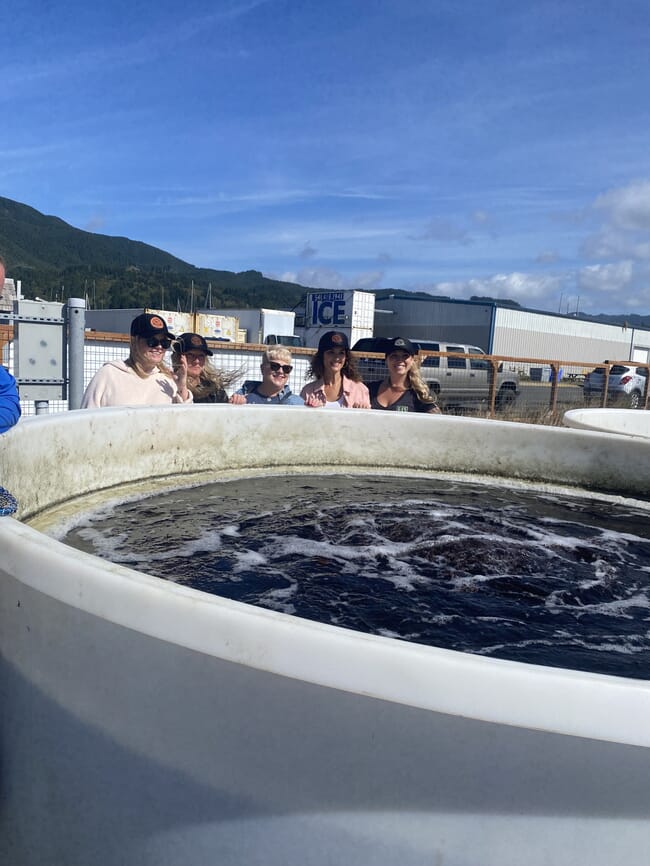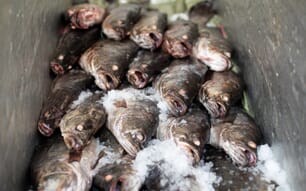
Chuck Toombs doesn’t talk up seaweed’s ability to store carbon, improve water quality or enhance biodiversity. For him, seaweed is a chance discovery which offered a strong – and largely overlooked – business case.
It all started in 2015, when he was leading a marketing class at Oregon State University, which he’d joined after selling his previous company, Ostrom Glass & Metal Works. As part of a project for his students he was looking for technologies ripe for marketing drives. A chance visit to university’s Hatfield Marine Science Center, included a tour of Chris Langdon’s seaweed research lab, where they were growing a strain of Pacific dulse (Devaleraea mollis) which grew fast and didn't go through a sexual cycle.
Toombs suggested that the speedy growing, healthy strain could be the "new kale” and asked one of Portland’s leading chefs, Vitaly Paley – who’d never heard of dulse and was pretty sceptical about the idea when Toombs turned up on his doorstep with a cooler of the stuff – to see if he could make it palatable.
“So about three days later, he called me on my phone. He said, ‘Chuck, I've got to have this. I've got to have ten pounds a week. I’m putting it on my menu’. And I said, ‘why?’ And he said, ‘because I put some in the deep fryer for about five seconds, pulled it out, and it tastes like bacon’.”
It was a revelation that was to give seaweed – and Toombs – their 15 minutes of fame.
“Oregon State, not to miss a beat from a PR standpoint, had a press release in the summer of 2015 where they had discovered a seaweed that tastes like bacon. And of course, that went viral. That went all over the world,” Toombs chuckles.
Three weeks later, Toombs found himself on the Today show, and following a flurry of calls from interested parties, it dawned on him that dulse farming could be a money-spinning business.
As a result, he decided to establish a 10 tank dulse farm in Bandon, which was essentially a larger version of what Langdon was doing in OSU’s labs. It was swiftly followed by a grant-funded 20 tank farm in Garibaldi.
It’s a model that contrasted markedly with the nascent kelp sector, which was beginning to emerge at the same time, but was still on a very small scale.
“This was all before Greenwave and kelp and that sort of business model started getting funded by the World Wildlife Fund. And then the idea behind that [kelp farming] was, you know, let's take out of work lobster farmers and put them in the seaweed business and in the hope that someone will buy the product,” Toombs reflects.
“But what occurred to me was that the business model that I have is far superior in the sense that we're growing this stuff on land. So we can feed it, we can watch it, we can change the pH, we can bubble it harder, we can bubble it softer, and we can get a product exactly what we want,” he adds.

© Oregon Seaweed
“The kelp people, where they had to grow lines of this stuff, they had to, you know, pray that it grew because there was no way to feed it. And then they had to harvest it all at one time, and they had to process it all at one time. So that you had to have a processing facility that was an acre big that only worked a week, a year, you know, and I'm going, wow, what are they doing? What's the point there?” he asks.
Despite all the media and culinary interest Toombs struggled to find investors in the US.
“It was early in the seaweed business and the NGOs weren't attracted to me because I was small. And I couldn't find food investors, as they were still looking for the next hot sauce,” he reflects.
However, he did secure an equity investment from Katapult Ocean in Oslo, but then Covid hit and his main customer base – high end restaurants – shut their doors, leaving him with two operational seaweed farms and nowhere to sell to.
Despite this, the startup survived the pandemic and Toombs believes that there’s now enough momentum to justify scaling his production as well as developing the capabilities to process his dulse into a greater range of products – not just for the food sector.
“Now Covid's over, we're scaling, and we're finding there is a fresh market for our product. We've opened up sales with some retailers, and we're putting our seaweed right next to kale. We're saying ‘twice the nutrition, a fraction of the carbon footprint and it tastes like bacon when you fry it’”, he points out.
“We're slowly developing that fresh market and now we're also being called for ingredients, in spice blends. Another big one is the pet food business. Turns out that our seaweed's got taurine in it, and taurine is an amino acid that cats can't produce. So 99 percent of all the taurine is synthetically made in China. And I don't know if you know much about the pet food business, but they're spending more on pets than they are on humans,” he adds.
As a result, Toombs thinks that Oregon Seaweed is on the cusp of being profitable for the first time.
“We think we'll be in the black this year because we've got products that are coming into the market. We're developing new products and we’re going to be launching seaweed snacks that are made in South Korea and sell them for 10 percent less – people here are paying $100 a pound for these snacks,” he marvels.

© Oregon Seaweed
However, Toombs at pains to differentiate his product from line-grown kelp, which he sees as more of a commodity product, and so will be working hard on branding it. He also points to his experience with retailers, having done business with the likes of Costco, Walmart and Home Depot.
“We're kind of thinking we're the pinot noir of seaweeds because right now the American public are getting to know seaweed, but they're getting to know it in a way that I don't think is in our interest,” he argues.
Sensing opportunities, and nearing capacity on his first two sites, Toombs is now looking to expand his production from 30,000 lb (13 tonnes) a year to 500,000 lb (225 tonnes) and aims to raise $3 million to scale production and build an on-site processing facility.
“Our next farm is going to be a 600-tank-equivalent farm over 6 acres. We don’t yet know what the tanks are going to look like, as the farms of tomorrow won’t look like the farms of today. 70 percent of the cost of producing my product is simply energy – I’m confident we can cut that in half,” he explains.
He’s also planning to continue to refine his production protocols, and says he’s found a way to increasing the protein levels of dulse from 20 percent (dry weight) to 45 percent by changing variables in the tanks. It’s a breakthrough that’s helped Oregon Seaweed reach the finals of the Bezos AI for Nature and Climate Grand Challenge.
“We’ve got this high protein seaweed, we know it works in plant-based food applications, but the question they’re asking is whether we can apply AI to our system to improve efficiencies. The answer is ‘yes’ – we can put sensors in every tank, we can measure data, we can change tank dimensions, we can change flow rates,” Toombs points out.
He's also considering establishing an inland farm in eastern Oregon, where there are saline wells, an initiative that he’s working on with Oregon State University.
“The math works that the world needs 360 million metric tonnes of protein a year and we can grow that entire amount [using dulse] on a geography the size of Connecticut. We know we have a viable product but we need to make the leap of getting people to use that product,” he concludes.








